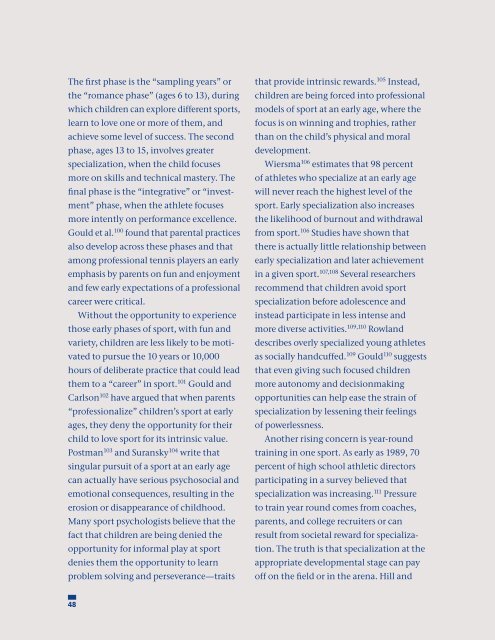True-Sport-Report
You also want an ePaper? Increase the reach of your titles
YUMPU automatically turns print PDFs into web optimized ePapers that Google loves.
The first phase is the “sampling years” or<br />
the “romance phase” (ages 6 to 13), during<br />
which children can explore different sports,<br />
learn to love one or more of them, and<br />
achieve some level of success. The second<br />
phase, ages 13 to 15, involves greater<br />
specialization, when the child focuses<br />
more on skills and technical mastery. The<br />
final phase is the “integrative” or “investment”<br />
phase, when the athlete focuses<br />
more intently on performance excellence.<br />
Gould et al. 100 found that parental practices<br />
also develop across these phases and that<br />
among professional tennis players an early<br />
emphasis by parents on fun and enjoyment<br />
and few early expectations of a professional<br />
career were critical.<br />
Without the opportunity to experience<br />
those early phases of sport, with fun and<br />
variety, children are less likely to be motivated<br />
to pursue the 10 years or 10,000<br />
hours of deliberate practice that could lead<br />
them to a “career” in sport. 101 Gould and<br />
Carlson 102 have argued that when parents<br />
“professionalize” children’s sport at early<br />
ages, they deny the opportunity for their<br />
child to love sport for its intrinsic value.<br />
Postman 103 and Suransky 104 write that<br />
singular pursuit of a sport at an early age<br />
can actually have serious psychosocial and<br />
emotional consequences, resulting in the<br />
erosion or disappearance of childhood.<br />
Many sport psychologists believe that the<br />
fact that children are being denied the<br />
opportunity for informal play at sport<br />
denies them the opportunity to learn<br />
problem solving and perseverance—traits<br />
that provide intrinsic rewards. 105 Instead,<br />
children are being forced into professional<br />
models of sport at an early age, where the<br />
focus is on winning and trophies, rather<br />
than on the child’s physical and moral<br />
development.<br />
Wiersma 106 estimates that 98 percent<br />
of athletes who specialize at an early age<br />
will never reach the highest level of the<br />
sport. Early specialization also increases<br />
the likelihood of burnout and withdrawal<br />
from sport. 106 Studies have shown that<br />
there is actually little relationship between<br />
early specialization and later achievement<br />
in a given sport. 107,108 Several researchers<br />
recommend that children avoid sport<br />
specialization before adolescence and<br />
instead participate in less intense and<br />
more diverse activities. 109,110 Rowland<br />
describes overly specialized young athletes<br />
as socially handcuffed. 109 Gould 110 suggests<br />
that even giving such focused children<br />
more autonomy and decisionmaking<br />
opportunities can help ease the strain of<br />
specialization by lessening their feelings<br />
of powerlessness.<br />
Another rising concern is year-round<br />
training in one sport. As early as 1989, 70<br />
percent of high school athletic directors<br />
participating in a survey believed that<br />
specialization was increasing. 111 Pressure<br />
to train year round comes from coaches,<br />
parents, and college recruiters or can<br />
result from societal reward for specialization.<br />
The truth is that specialization at the<br />
appropriate developmental stage can pay<br />
off on the field or in the arena. Hill and<br />
48


